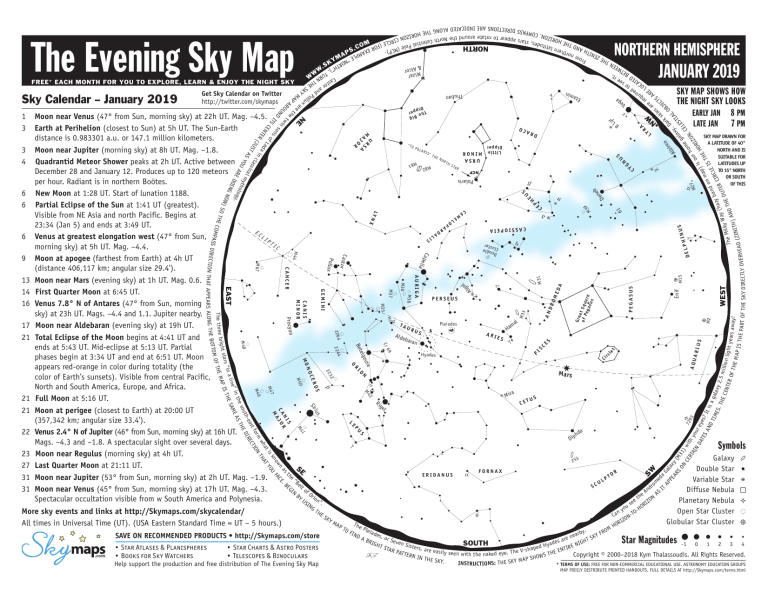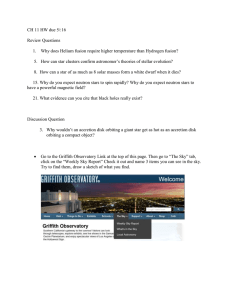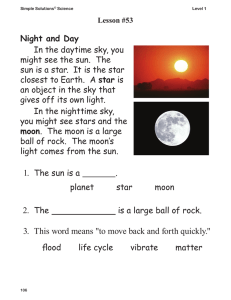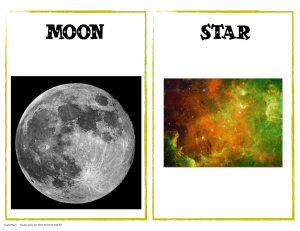January 2019 Evening Sky Map: Northern Hemisphere
advertisement

R Ly r Big ε ie The per t s e Dip J E a re Ve ar AR ga CT x re Eta S ll u A P q m an u ub A ν Th in M Po i R r e E d n d SKY L t O o ra C E s A T st o TH ED e e i Ca t . RN B ar iz E TU M TW r o lc E ”) . A E & N R TH T H F r E o “NO m Z EN n LE o I r t T MP he H r CP). n A EXA la N NORTH t D i le ( N t u F OR TH d es al P o E , s LE ( t H a r s ap OR C el e s t i p C IR C e I a r Z t o O r o t a t e around the North N . CO R IZ O N MPASS THE HO DIRECTIONS AR E INDICATED ALONG JANUARY 2019 A R De 9 M3 C CA δ CASSIOPEIA OP AR DA LI Dou Clus ble ter ED Al OM S go l γ A M31 G re a of t S q u Pe g a a s u re s EL AN S γ CE ES t le Hyades rc Ci 69 IS Cr 4 e eus N elg IO R 224 Bet n P M1 M33 DR M35 2264 O MO 22 NO 32 CE Mars β σ 0 RO M5 Enif M15 1) wi 72 th RT 93 A y AI QUA N D o ur RIU eye S AT s? ES It i AN M2 sa DT gala IME xy 2 S. T .5 m HE i ll i o n WEST CE N l ig h t y TE R ears a w a y OF T ! HE M AP IS T HE PART OF THE SKY DIRECTLY O η M M38 AURIGA M36 M37 GEMINI CANIS MINOR ARI M4 S Mira 2 ius Sir Ri ge l CE TU S LE P U • Star Charts & Astro Posters • Telescopes & Binoculars Help support the production and free distribution of The Evening Sky Map M3 y( AR S la x PE W AP to fO ri US on”. IN G TH ES S E BY ed S ERIDANUS FORNAX Symbols Galaxy Double Star OR PT Variable Star L m U o SC T dr Diffuse Nebula A n AS I e th ON Planetary Nebula ee IZ u s HOR o y Open Star Cluster O n -T Ca ON Globular Star Cluster RI Z O H Ga S 1 el α 53 a M4 a hd Dip CE S EU EP H μ C r ape lla Casto Pollux M44 he S Procyon t CANCER NI R as E. B n CA O C AJ ow FA M k n OU 7 M4 is Y at AT wh TH M6 46 7 N rm M o t f ECTIO eas th DI R M48 s ou HE ST th e EA ” in line SAM EAST in a HE ta rs “ IS T righ t s MA P T he t hre e b F T HE TTOM O N THAT APPEARS ALONG THE BO bara US ON Polaris β PASS D IRECTIO Alde l ma Ha Pleiades UR χ M81 M82 LY N X E C OM TA 2 “B IN PERSEUS SKY MAP DRAWN FOR A LATITUDE OF 40° NORTH AND IS SUITABLE FOR LATITUDES UP TO 15° NORTH OR SOUTH OF THIS o ire Alb S U N CY R PEGASUS S TA G H 61 RT b ne E N O NCP TH URSA S” Little M I N O R Dipper ARI LY O POL AC U M R S JO A R A ) SO TH EG SKY MAP SHOWS HOW THE NIGHT SKY LOOKS EARLY JAN 8 PM LATE JAN 7 PM N E “ TO γ SAVE ON RECOMMENDED PRODUCTS • http://Skymaps.com/store • Star Atlases & Planispheres • Books for Sky Watchers NORTHERN HEMISPHERE N Moon near Venus (47° from Sun, morning sky) at 22h UT. Mag. –4.5. Earth at Perihelion (closest to Sun) at 5h UT. The Sun-Earth distance is 0.983301 a.u. or 147.1 million kilometers. 3 Moon near Jupiter (morning sky) at 8h UT. Mag. –1.8. 4 Quadrantid Meteor Shower peaks at 2h UT. Active between December 28 and January 12. Produces up to 120 meteors per hour. Radiant is in northern Boötes. 6 New Moon at 1:28 UT. Start of lunation 1188. 6 Partial Eclipse of the Sun at 1:41 UT (greatest). Visible from NE Asia and north Pacific. Begins at 23:34 (Jan 5) and ends at 3:49 UT. EC LI 6 Venus at greatest elongation west (47° from Sun, PT IC morning sky) at 5h UT. Mag. –4.4. 9 Moon at apogee (farthest from Earth) at 4h UT (distance 406,117 km; angular size 29.4'). 13 Moon near Mars (evening sky) at 1h UT. Mag. 0.6. 14 First Quarter Moon at 6:45 UT. 16 Venus 7.8° N of Antares (47° from Sun, morning sky) at 23h UT. Mags. –4.4 and 1.1. Jupiter nearby. 17 Moon near Aldebaran (evening sky) at 19h UT. 21 Total Eclipse of the Moon begins at 4:41 UT and ends at 5:43 UT. Mid-eclipse at 5:13 UT. Partial phases begin at 3:34 UT and end at 6:51 UT. Moon appears red-orange in color during totality (the color of Earth’s sunsets). Visible from central Pacific, North and South America, Europe, and Africa. 21 Full Moon at 5:16 UT. 21 Moon at perigee (closest to Earth) at 20:00 UT (357,342 km; angular size 33.4'). 22 Venus 2.4° N of Jupiter (46° from Sun, morning sky) at 16h UT. Mags. –4.3 and –1.8. A spectacular sight over several days. 23 Moon near Regulus (morning sky) at 4h UT. 27 Last Quarter Moon at 21:11 UT. 31 Moon near Jupiter (53° from Sun, morning sky) at 2h UT. Mag. –1.9. 31 Moon near Venus (45° from Sun, morning sky) at 17h UT. Mag. –4.3. Spectacular occultation visible from w South America and Polynesia. More sky events and links at http://Skymaps.com/skycalendar/ All times in Universal Time (UT). (USA Eastern Standard Time = UT – 5 hours.) 1 3 M DR Get Sky Calendar on Twitter http://twitter.com/skymaps he OU t wi n N s D IT o n s S CE o f L e N T ER d a i (JU n cl ass ST i A S Y c al m yth OU o lo AR gy. E DOI NG NOW Sky Calendar – January 2019 W M CO W W FREE* EACH MONTH FOR YOU TO EXPLORE, LEARN & ENJOY THE NIGHT SKY KY S. sk rk B Da L O . y A a x S TI l S a g NU LE PHI m e . CE DEL γ N ho 7 ZO ur M2 I o R is HO p) HE ma ST on I d LE ba n I RC azy RC y (h UT E y Wa O k l i E M H The ND T T H) A ( ZE N I V E R H E AD The Evening Sky Map .S W AP KY MA θ The PT P M OF l . I N D e ia d e s F RO rb y , or nea SKY AB Seve s ar e HT RIG e G d I n a SOUTH -1 0 1 2 3 4 y N HT S S i s t er pe d H s, are e TAR T IRE e V-s ha a s ily s e e n w i t PATT E EN H T h the naked eye. Th E RN I S Copyright © 2000–2018 Kym Thalassoudis. All Rights Reserved. W N THE S AP SHO KY. INSTRUCTIONS: THE SKY M * TERMS OF USE: FREE FOR NON-COMMERCIAL EDUCATIONAL USE. ASTRONOMY EDUCATION GROUPS Star Magnitudes MAY FREELY DISTRIBUTE PRINTED HANDOUTS. FULL DETAILS AT http://Skymaps.com/terms.html Tips for Observing the Night Sky When observing the night sky, and in particular deep-sky objects such as star clusters, nebulae, and galaxies, it’s always best to observe from a dark location. Avoid direct light from street lights and other sources. If possible observe from a dark location away from the light pollution that surrounds many of today’s large cities. You will see more stars after your eyes adapt to the darkness—usually about 10 to 20 minutes after you go outside. Also, if you need to use a torch to view the sky map, cover the light bulb with red cellophane. This will preserve your dark vision. Finally, even though the Moon is one of the most stunning objects to view through a telescope, its light is so bright that it brightens the sky and makes many of the fainter objects very difficult to see. So try to observe the evening sky on moonless nights around either New Moon or Last Quarter. Astronomical Glossary Conjunction – An alignment of two celestial bodies such that they present the least angular separation as viewed from Earth. Constellation – A defined area of the sky containing a star pattern. Diffuse Nebula – A cloud of gas illuminated by nearby stars. Double Star – Two stars that appear close to each other in the sky; either linked by gravity so that they orbit each other (binary star) or lying at different distances from Earth (optical double). Apparent separation of stars is given in seconds of arc ("). Ecliptic – The path of the Sun’s center on the celestial sphere as seen from Earth. Elongation – The angular separation of two celestial bodies. For Mercury and Venus the greatest elongation occurs when they are at their most angular distance from the Sun as viewed from Earth. Galaxy – A mass of up to several billion stars held together by gravity. Globular Star Cluster – A ball-shaped group of several thousand old stars. Light Year (ly) – The distance a beam of light travels at 300,000 km/sec in one year. Magnitude – The brightness of a celestial object as it appears in the sky. Open Star Cluster – A group of tens or hundreds of relatively young stars. Opposition – When a celestial body is opposite the Sun in the sky. Planetary Nebula – The remnants of a shell of gas blown off by a star. Universal Time (UT) – A time system used by astronomers. Also known as Greenwich Mean Time. USA Eastern Standard Time (for example, New York) is 5 hours behind UT. Variable Star – A star that changes brightness over a period of time. JANUARY 2019 CELESTIAL OBJECTS Listed on this page are several of the brighter, more interesting celestial objects visible in the evening sky this month (refer to the monthly sky map). The objects are grouped into three categories. Those that can be easily seen with the naked eye (that is, without optical aid), those easily seen with binoculars, and those requiring a telescope to be appreciated. Note, all of the objects (except single stars) will appear more impressive when viewed through a telescope or very large binoculars. They are grouped in this way to highlight objects that can be seen using the optical equipment that may be available to the star gazer. NORTHERN HEMISPHERE About the Celestial Objects Easily Seen with the Naked Eye Capella Sirius Procyon δ Cephei Deneb Castor Pollux Vega Rigel Betelgeuse Algol Pleiades Hyades Aldebaran Polaris Aur CMa CMi Cep Cyg Gem Gem Lyr Ori Ori Per Tau Tau Tau UMi The 6th brightest star. Appears yellowish in color. Spectroscopic binary. Dist=42 ly. The brightest star in the sky. Also known as the "Dog Star". Dist=8.6 ly. Greek name meaning "before the dog" - rises before Sirius (northern latitudes). Dist=11.4 ly. Cepheid prototype. Mag varies between 3.5 & 4.4 over 5.366 days. Mag 6 companion. Brightest star in Cygnus. One of the greatest known supergiants. Dist=1,400 ±200 ly. Multiple star system with 6 components. 3 stars visible in telescope. Dist=52 ly. With Castor, the twin sons of Leda in classical mythology. Dist=34 ly. The 5th brightest star in the sky. A blue-white star. Dist=25.0 ly. The brightest star in Orion. Blue supergiant star with mag 7 companion. Dist=770 ly. One of the largest red supergiant stars known. Diameter=300 times that of Sun. Dist=430 ly. Famous eclipsing binary star. Magnitude varies between 2.1 & 3.4 over 2.867 days. The Seven Sisters. Spectacular cluster. Many more stars visible in binoculars. Dist=399 ly. Large V-shaped star cluster. Binoculars reveal many more stars. Dist=152 ly. Brightest star in Taurus. It is not associated with the Hyades star cluster. Dist=66.7 ly. The North Pole Star. A telescope reveals an unrelated mag 8 companion star. Dist=433 ly. Easily Seen with Binoculars M31 M2 M38 M36 M37 M44 M41 μ Cephei Mira χ Cygni M39 ν Draconis M35 γ Leporis R Lyrae 2232 2244 M50 Cr 69 M42 M15 Double Cluster 253 Mizar & Alcor And Aqr Aur Aur Aur Cnc CMa Cep Cet Cyg Cyg Dra Gem Lep Lyr Mon Mon Mon Ori Ori Peg Per Scl UMa The Andromeda Galaxy. Most distant object visible to naked eye. Dist=2.5 million ly. Resembles a fuzzy star in binoculars. Stars appear arranged in "pi" or cross shape. Dist=4,300 ly. About half size of M38. Located in rich Milky Way star field. Dist=4,100 ly. Very fine star cluster. Discovered by Messier in 1764. Dist=4,400 ly. Praesepe or Beehive Cluster. Visible to the naked eye. Dist=590 ±20 ly. First recorded observation by Aristotle in 325 BC as "cloudy spot". Dist=2,300 ly. Herschel's Garnet Star. One of the reddest stars. Mag 3.4 to 5.1 over 730 days. Famous long period variable star. Mag varies between 3.0 & 10.1 over 332 days. Long period pulsating red giant. Magnitude varies between 3.3 & 14.2 over 407 days. May be visible to the naked eye under good conditions. Dist=900 ly. Wide pair of white stars. One of the finest binocular pairs in the sky. Dist=100 ly. Fine open cluster located near foot of the twin Castor. Dist=2,800 ly. Visible with binoculars. Gold & white stars. Mags 3.6 & 6.2. Dist=30 ly. Sep=96.3". Semi-regular variable. Magnitude varies between 3.9 & 5.0 over 46.0 days. A large scattered star cluster of 20 stars. Dist=1,300 ly. Surrounded by the rather faint Rosette Nebula. Dist=5,540 ly. Visible with binoculars. Telescope reveals individual stars. Dist=3,000 ly. Lambda Orionis Cluster. Dist=1,630 ly. The Great Orion Nebula. Spectacular bright nebula. Best in telescope. Dist=1,300 light years. Only globular known to contain a planetary nebula (Mag 14, d=1"). Dist=30,000 ly. Double Cluster in Perseus. NGC 869 & 884. Excellent in binoculars. Dist=7,300 ly. Fine, large, cigar-shaped galaxy. Requires dark sky. Member of Sculptor Group. Good eyesight or binoculars reveals 2 stars. Not a binary. Mizar has a mag 4 companion. Telescopic Objects γ Andromedae γ Arietis M67 η Cassiopeiae 61 Cygni γ Delphini θ Eridani β Monocerotis 2264 σ Orionis M1 M33 M81 M82 And Ari Cnc Cas Cyg Del Eri Mon Mon Ori Tau Tri UMa UMa Attractive double star. Bright orange star with mag 5 blue companion. Sep=9.8". Impressive looking double blue-white star. Visible in a small telescope. Sep=7.8". Contains 500+ stars mag 10 & fainter. One of the oldest clusters. Dist=2,350 ly. Yellow star mag 3.4 & orange star mag 7.5. Dist=19 ly. Orbit=480 years. Sep=12". Attractive double star. Mags 5.2 & 6.1 orange dwarfs. Dist=11.4 ly. Sep=28.4". Appear yellow & white. Mags 4.3 & 5.2. Dist=100 ly. Struve 2725 double in same field. Striking blue-white double star. Mags 3.2 & 4.3. Visible in a small telescope. Sep=8.2". Triple star. Mags 4.6, 5.0 & 5.4. Requires telescope to view arc-shape. Sep=7.3". Christmas Tree Cluster. Associated with the Cone Nebula. Dist=2,450 ly. Superb multiple star. 2 mag 7 stars one side, mag 9 star on other. Struve 761 triple in field. Crab Nebula. Remnant from supernova which was visible in 1054. Dist=6,500 ly. Fine face-on spiral galaxy. Requires a large aperture telescope. Dist=2.3 million ly. Beautiful spiral galaxy visible with binoculars. Easy to see in a telescope. Close to M81 but much fainter and smaller. The Evening Sky Map (ISSN 1839-7735) Copyright © 2000–2018 Kym Thalassoudis. All Rights Reserved.



